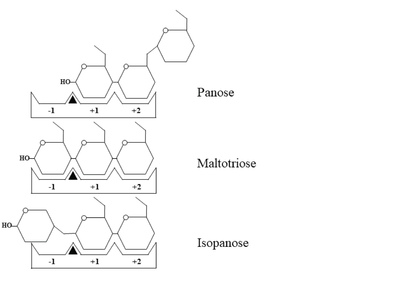Journal:Acta Cryst D:S205979832100677X
From Proteopedia

A GH13 α-glucosidase from Weissella cibaria uncommonly acts on short-chain maltooligosaccharidesKaran Wangpaiboon, Pasunee Laohawuttichai, Sun-Yong Kim, Tomoyuki Mori, Santhana Nakapong, Rath Pichyangkura, Piamsook Pongsawasdi, Toshio Hakoshima and Kuakarun Krusong [1] Molecular Tour . Lighter colors represent different subunit of dimer.
WcAG formed a , creating the substrate-binding groove. The residues near the dimer interface are shown in dark blue and deep sky blue sticks, while the maltotriose and catalytic residues are represented by yellow and magenta, respectively. Ligand binding sites: The carbon, nitrogen and oxygen atoms of the bound ligands are displayed in cyan/yellow, blue and red, respectively. The three catalytic residues are shown in salmon sticks. The active site of WcAG was naturally designed to fit perfectly with maltotriose. . E374/E374Q, D440, and D345/D345N are the catalytic residues (yellow) and other amino acid residues in/near the active site are shown in salmon. The asterisk and magenta colour present the residue from another subunit. The maltotriose is shown in cyan. White dashes represent hydrogen bonds. (grey) (PDB ID: 7ehi) is clearly observed by superimposition with maltotriose in WcAG structure (cyan) (PDB ID: 7dcg). The in front of the active site modulates the substrate specificity of WcAG. This scene represents the movement of R176, E296 and F295 at two loops (P174-Y180 and T290-D300) in front of the active site when there is no substrate bound (grey) and when the active site is occupied by acarbose (salmon). (PDB ID: 2d2o). References
| |||||||||||

